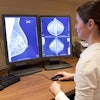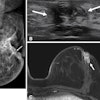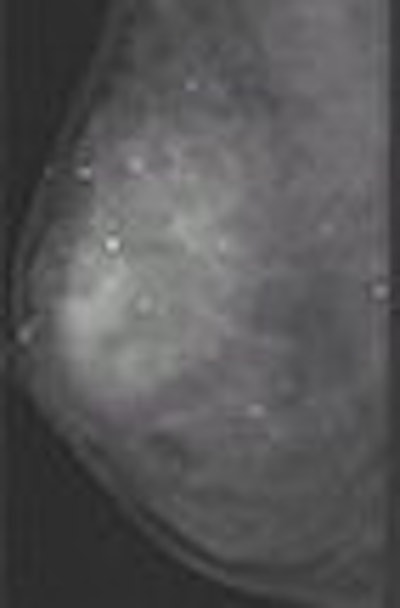
Full-field digital mammography (FFDM) is superior to film-screen mammography (FSM) for detecting cancers in younger women, according to the results of a major nationwide study released today. However, the digital modality was no better than FSM as a screening tool in the general population.
The Digital Mammographic Imaging Screening Trial (DMIST), sponsored by the American College of Radiology Imaging Network (ACRIN), involved nearly 50,000 asymptomatic women who presented for screening mammography at 33 sites in the U.S. and Canada.
FFDM also proved more accurate in women with radiographically dense breasts, premenopausal women, and perimenopausal women, wrote DMIST lead investigator Dr. Etta Pisano and colleagues in the New England Journal of Medicine (September 16, 2005).
In addition, "digital mammography offers other advantages over film mammography -- namely, easier access to images and computer-assisted diagnosis; improved means of transmission, retrieval, and storage of images; and the use of a lower average dose of radiation without a compromise in diagnostic accuracy," wrote the DMIST investigators.
The women in the trial underwent both FFDM and FSM. Five different FFDM systems were used:
- SenoScan (Fischer Imaging, Denver)
- Computed Radiography for Mammography (Fujifilm Medical Systems USA, Stamford, CT)
- Senographe 2000D (GE Healthcare, Chalfont St. Giles, U.K.)
- Selenia Full Field Digital Mammography System (Hologic, Bedford, MA)
- Lorad/Trex Digital Mammography System (Hologic), subsequently replaced by Lorad/Hologic Selenia Full Field Digital Mammography System (Hologic)
FFDM and FSM exams were independently read by two radiologists who rated the mammograms using a seven-point malignancy scale (1 meant not malignant, 4 meant may be malignant, 7 meant definitely malignant). The readers also rated breast density according to the standard BI-RADS scale. After exclusions, primary data was available for 47,760 women. Details of the trial methodology were previously published in Radiology (August 2005, Vol. 236:2, pp. 404-412).
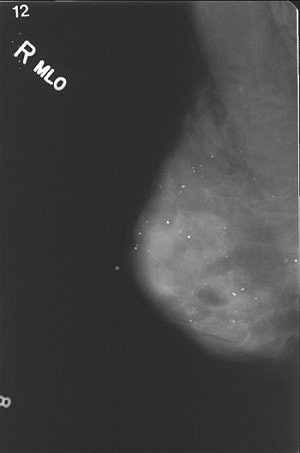 |
| FSM (above) and FFDM (below) scans from a 47-year-old woman with dense breasts. Images courtesy of Edward Hendrick, Ph.D., department of radiology, Feinberg School of Medicine, Northwestern University, Chicago. |
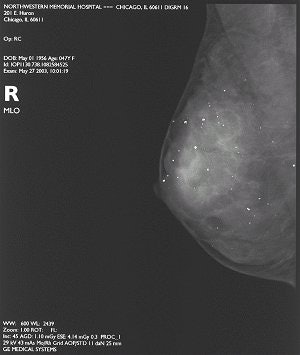 |
Based on the interpretation of the images, 223 women (0.5%) had positive FFDM and FSM mammograms, 947 (22.2%) had only positive FFDM results, and 832 (1.9%) had positive FSM results. A total of 335 breast cancers were diagnosed during the 455 days after study entry in 2001.
In the entire population, the study results showed that the diagnostic accuracy of FFDM and FSM was similar (0.03 area under ROC curve; 95% CI, p = 0.18). For all women, FFDM and FSM turned in a sensitivity of 41% and a specificity of 98%. The positive predictive value (PPV) of FFDM was 12%; the PPV for FSM was 13%.
FFDM's accuracy was significantly higher than FSM in women under the age of 50 (0.15 area under ROC curve; 95% CI, p = 0.002) and in women with dense or extremely dense breasts (0.11 area under ROC curve; 95% CI, p= 0.002).
In younger women, FFDM's sensitivity was 49% (versus 35% for FSM), the specificity was 97% (98% for FSM), and the PPV was 8% (7% FSM). Finally, for women with dense breasts, the sensitivity for FFDM was 38% (36% FSM), while the specificity for both modalities was 97% and the PPVs were 10%.
In the older population, FFDM detected invasive and high-grade in-situ cases, the authors explained. "These are precisely the lesions that must be detected early to save lives through screening," they wrote.
The authors acknowledged that the sensitivity for both modalities used in DMIST was lower than in previous studies. They attributed this to a longer follow-up interval for reporting estimates so that each site could complete one-year follow-up, as well as any necessary workup.
Despite these promising results, the group also admitted that cost is still a major obstacle for implementing FFDM, with the new technology costing as much as four times more than FSM. An in-depth cost-effectiveness analysis will be performed as part of DMIST, they stated.
By Shalmali Pal
AuntMinnie.com staff writer
September 16, 2005
Related Reading
Digital mammography presents PACS challenges, July 8, 2005
Anode/filter combination enables lower dose in FFDM, March 6, 2005
ACRIN updates multiple breast cancer trials, April 15, 2004
Key variables impact accuracy of digital mammography, April 21, 2003
Copyright © 2005 AuntMinnie.com
